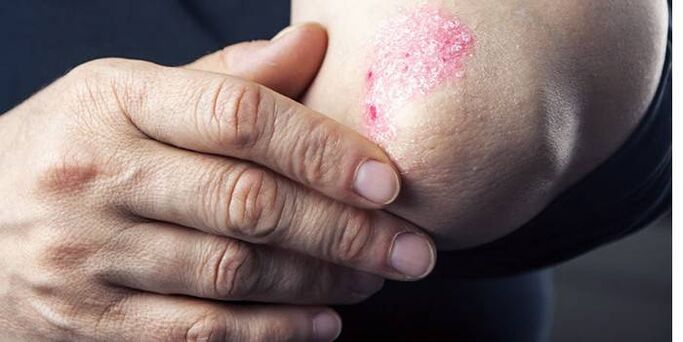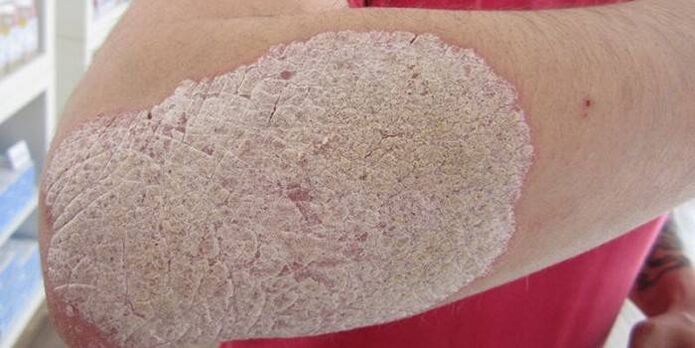Skin conditions are accompanied by unpleasant symptoms and the appearance of psychological discomfort. One of the common diseases that requires immediate skin treatment is psoriasis of the elbow, the choice of treatments is not limited to the use of topical preparations. If you don’t do the therapy on time, a little inflammation will soon turn from a cosmetic problem to a medicine.
What is psoriasis on the elbow
The disease, which is characterized by the appearance of more spots when bending the limbs, is characterized by unpredictability and cyclicality. Elbow psoriasis is a chronic skin condition that begins with the appearance of papules and grows into plaques (large diffuse lesions) with white, silvery, reddish hues. Slightly elevated damaged areas develop due to the accumulation of dry dead cells. If the inflammation is not treated, the disease progresses with alternating periods of exacerbation and remission.
Symptoms
When a crust forms on your elbow, you may immediately notice damaged areas of skin. Signs of the disease are immediately visible, and it is seldom possible to completely cure psoriasis in the area of the arms. Patients who see a doctor in time have a chance of successful recovery. Elderly skin conditions that are similar to the following symptoms of psoriasis are of concern:
- Red plaques, or scaly patches that initially appear as papules with a white film layer and grow as the disease worsens and progresses, connect, and are covered with white scales.
- Itchy skin that causes even more skin damage. Like other mechanical damage to the skin, such as scratches, cuts, such inflammations of the elbows are combed, damage the skin, and lead to the appearance of new spots.
- Severe redness of the skin, inflamed areas begin to bleed.

Plaques on the elbows
Psoriasis can occur in the lumbar region, trunk, limbs, or head, but wherever the disease is localized, plaques are a sure sign. Wounds on the elbows in the form of red spots with white scales are more common due to the openness of this part of the skin as it can be easily damaged. The altered area of the epidermis becomes inflamed, the red, scaly patches gradually grow and cover the entire elbow. In a neglected form, plaques may bleed, and when scraping is attempted, the phenomenon of "stearin stain" appears as a drop after hardened wax.
Cause
Ongoing scientific studies have not yet been able to determine with complete certainty the source of the disease, and medical options for the causes of psoriasis in the elbow include:
- Genetic predisposition is an important statistical factor. If one parent has chronic dermatitis, there is a high chance that the child will also get psoriasis.
- Penetration of certain substances through damaged areas of the skin. The affected areas of the epidermis begin to thicken, the body begins to fight the pathological symptoms and expels the cells, which appear outward as fungi on the elbow.
- Violation of the work of T lymphocytes, which face the task of creating a barrier to pathogens.
- Silicon deficiency in the body.
- Endocrine diseases.
- Severe limb injuries.
- Serious mechanical injuries, non-healing wounds.
- Emotional, mental stress.
- Long-term medication.
- Weak immunity.

platoon
It is a chronic inflammatory process in the elbow that intensifies or decreases for a number of reasons and progresses without proper treatment. The course of therapy must be prescribed by a dermatologist, but in order to determine the effectiveness of the method and the choice of drugs and procedures, the doctor must assess the course of the disease. Additional tactics depend on the clinical picture, while the following stages of elbow skin lesions are commonly distinguished from psoriasis:
- The initial. On the outside of the elbow, the surface of the skin is covered with a rash. Reddish, rounded, white film-stained spots grow, are covered with scales, and plaques form after 2-3 weeks. With timely treatment, the signs of psoriasis may disappear for a while and then reappear, or the lesion may appear in another part of the body.
- Advanced. This stage of the disease is characterized by the presence of psoriatic elements in many psoriasis. The appearance of such signs indicates the onset of exacerbation of psoriasis, and this is readily apparent in the presence of a hyperemic rim (blush) at the edge of the scaly plaque.
- Stationary. It is characterized by a decrease in the inflammatory process, which indicates the effectiveness of the treatment used. The appearance of new plaques on the elbow stops, there are no red edges around the psoriasis elements, their diameter decreases, while the scales completely cover the inflamed area.
- Decreasing. Indicates partial recovery, while exfoliation is almost imperceptible or disappears, with pigmented skin areas appearing in place of plaques. An additional package of measures is aimed at preventing the worsening of psoriasis.

Forms
The fluctuating course of the disease, alternating with improvement over a spontaneous period, is not the only component of psoriasis insomnia. The severity of the course of the inflammatory process depends on the nature of the rash, another important factor being its shape. With the localization of elbow rashes, a simple (vulgar) type of disease often occurs, characterized by redness, peeling, itching. The neglected form of the disease threatens with complications and the appearance of pustular, erythrodermic, seborrheic-type psoriasis, which expands the area of the lesion.
How to treat psoriasis on the elbow
There are effective therapies, but complete cleansing of the skin of the elbow will not work because psoriasis belongs to the group of incurable diseases. The complete system of complex treatment will be aimed at the maximum elimination of external signals. The duration of remission depends on a number of factors, and in order to prevent the development of psoriasis, it is recommended to set up a treatment regimen that uses the following basic methods:
- topical therapy (ointment, cream, lotion);
- physiotherapy procedures;
- phototherapy;
- special diet;
- taking vitamin and mineral complexes.
A cure for psoriasis on the elbow
The drugs are actively used in the treatment of a multifactorial disease, but their effectiveness can only be seen in combination with other means. External medications are commonly used to treat psoriasis, and the following medications may be prescribed if they do not work:
- cytostatics;
- antihistamines;
- enterosorbents.
Ointment
Rapid relief of the unpleasant symptoms of psoriasis is a topical treatment. Ointments containing vitamin D, zinc, tar help remove dead cells, hydrate the skin of the elbow, and hormonal agents help cope with more severe forms of the disease. Corticosteroids are relatively safe when used as directed by a doctor who has examined the psoriasis plaques on the elbow, assessed the condition of the upper layers, and assessed the extent of the lesion. Hormonal ointments should only be introduced into the treatment regimen by a dermatologist, self-medication is strictly prohibited!
Alternative treatment
Compresses, body lotions, decoctions, baths can rightly be considered no less useful methods of treating psoriasis. If the plaques on the elbows are covered with a white film, itching and redness at home can be conveniently removed by immersing the affected areas in a cool herbal solution for 7-10 minutes. The composition should be selected individually, boiled with boiling water, but hot baths should be avoided. Herbs useful in the treatment of psoriasis include:
- dandelion;
- chicory root;
- valerian root.

Prevention
We have no reason to assume that psoriasis goes away on its own, but self-medication is not worth it either because there is a risk of an exacerbation of a chronic disease. Removing the inflammatory process is the first step toward healing, as long-term remission requires adherence to physicians ’recommendations. To prevent worsening of psoriasis, the following preventive measures should be taken:
- follow a proper diet;
- excludes the use of alcoholic beverages, alcohol, sweets, spicy foods;
- get enough sleep while sleeping for at least 8 hours a day;
- avoid mechanical damage to the skin;
- monitors the internal condition of the body;
- develop skills to deal with stress;
- supports the functioning of the immune system, avoiding infectious diseases;
- minimizes exposure to household chemicals.
Photo of psoriasis on the elbow
























